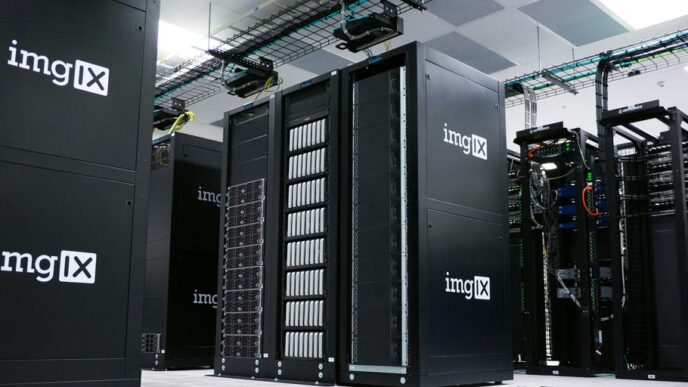Hyperautomation is changing the way businesses operate by combining advanced technologies to automate processes completely. This approach not only speeds up operations but also improves accuracy and efficiency. As companies strive for greater productivity, understanding hyperautomation becomes essential for success in a tech-driven world.
Key Takeaways
- Hyperautomation combines smart technologies to automate as many business processes as possible.
- It enhances efficiency, reduces costs, and improves decision-making through data analysis.
- Different tools and technologies work together to automate complex tasks beyond traditional methods.
- Businesses need to choose the right tools that can work well together for effective hyperautomation.
- The future of work will see increased collaboration between humans and machines, leading to innovative business practices.
Understanding Hyperautomation
Definition and Scope
Hyperautomation is the next level of automation. It combines various technologies like artificial intelligence (AI) and machine learning (ML) to automate many business processes. This means not just automating single tasks but creating a system where multiple processes can work together seamlessly. Hyperautomation involves several steps: discovering, analyzing, designing, automating, measuring, monitoring, and reassessing.
Key Technologies Involved
Hyperautomation uses a mix of technologies to achieve its goals. Here are some key components:
- Robotic Process Automation (RPA): Automates repetitive tasks.
- Artificial Intelligence (AI): Enhances decision-making and insights.
- Low-Code/No-Code Platforms: Allows users to create applications without extensive coding knowledge.
| Technology Type | Purpose |
|---|---|
| RPA | Automates manual tasks |
| AI | Provides intelligent insights |
| Low-Code/No-Code | Simplifies app development |
Difference Between Automation and Hyperautomation
While automation focuses on individual tasks, hyperautomation aims for a broader approach. Here are some differences:
- Scope: Automation handles single tasks; hyperautomation integrates multiple processes.
- Technology: Hyperautomation uses advanced technologies like AI and ML, while traditional automation may not.
- Impact: Hyperautomation can transform entire business operations, leading to greater efficiency and innovation.
Hyperautomation is not just about doing things faster; it’s about doing them smarter and more effectively.
The Business Case for Hyperautomation
Benefits for Enterprises
Hyperautomation offers numerous advantages for businesses looking to improve their operations. Here are some key benefits:
- Increased Efficiency: Automating repetitive tasks allows employees to focus on more important work.
- Cost Reduction: By minimizing manual errors and speeding up processes, companies can save money.
- Better Decision-Making: With advanced data analysis, businesses can make smarter choices based on real-time information.
Cost Savings and ROI
Investing in hyperautomation can lead to significant cost savings. A recent survey found that many organizations see a return on investment (ROI) within a year. Here’s a quick look at potential savings:
| Area | Estimated Savings |
|---|---|
| Operational Costs | Up to 30% |
| Labor Costs | 20% reduction |
| Error Reduction | 50% decrease in errors |
Enhanced Decision-Making
With the help of AI and machine learning, businesses can analyze large amounts of data quickly. This leads to:
- Deeper Insights: Understanding trends and patterns in data.
- Faster Responses: Making decisions based on current information.
- Strategic Planning: Aligning business goals with data-driven insights.
Hyperautomation is not just about technology; it’s about transforming how businesses operate and make decisions.
By embracing hyperautomation, companies can streamline their processes, save costs, and enhance their decision-making capabilities, ultimately leading to a more efficient and effective organization.
Key Technologies Driving Hyperautomation
Robotic Process Automation (RPA)
Robotic Process Automation (RPA) is a key technology in hyperautomation. It allows businesses to automate repetitive tasks by using software robots. RPA can handle tasks like data entry, invoice processing, and customer service inquiries. This technology helps reduce human error and speeds up processes.
Artificial Intelligence and Machine Learning
Artificial Intelligence (AI) and Machine Learning (ML) are crucial for making automation smarter. They analyze data and learn from it, enabling systems to make decisions without human input. For example, AI can predict customer behavior, which helps businesses tailor their services. Here are some benefits of AI and ML in hyperautomation:
- Improved accuracy in decision-making
- Enhanced customer experiences
- Ability to process large amounts of data quickly
Low-Code/No-Code Platforms
Low-Code and No-Code platforms allow users to create applications without extensive programming knowledge. This democratizes automation, enabling more people in an organization to contribute to automation efforts. These platforms are user-friendly and can help businesses quickly develop solutions tailored to their needs. They empower employees to automate their own tasks, leading to greater efficiency.
Hyperautomation is not just about technology; it’s about transforming how businesses operate and engage with their customers.
| Technology Type | Key Features | Benefits |
|---|---|---|
| Robotic Process Automation | Automates repetitive tasks | Reduces errors, speeds up processes |
| Artificial Intelligence | Learns from data, makes decisions | Improves accuracy, enhances experiences |
| Low-Code/No-Code | User-friendly application development | Empowers employees, quick solutions |
Implementing Hyperautomation in Your Organization
Steps to Get Started
To successfully implement hyperautomation, follow these essential steps:
- Assess Your Current Processes: Identify repetitive tasks that can be automated. Look for areas with high manual effort or frequent errors.
- Set Clear Objectives: Define what you want to achieve, such as reducing costs or improving customer satisfaction.
- Select the Right Tools: Choose user-friendly tools that fit your team’s skills and can work well together.
Choosing the Right Tools
When selecting tools for hyperautomation, consider:
- Ease of Use: Tools should be simple for everyone to use.
- Scalability: Ensure the tools can grow with your business needs.
- Interoperability: Tools must work well with existing systems to avoid inefficiencies.
Ensuring Interoperability
Interoperability is crucial for hyperautomation. It allows different tools to communicate effectively, which can lead to:
- Faster Processes: Streamlined workflows reduce delays.
- Cost Savings: Less manual work means lower operational costs.
- Better Decision-Making: Integrated data leads to more informed choices.
Hyperautomation is not just about technology; it’s about engaging everyone in the organization to contribute to the transformation. Empower your team to be part of this journey!
Use Cases of Hyperautomation
Customer Service Automation
Hyperautomation can significantly enhance customer service by automating repetitive tasks. For example, chatbots can handle common inquiries, allowing human agents to focus on more complex issues. This leads to:
- Faster response times
- Improved customer satisfaction
- Reduced operational costs
Finance and Accounting
In finance, hyperautomation streamlines processes like invoice processing and expense management. By automating these tasks, businesses can:
- Minimize errors
- Speed up transaction times
- Enhance compliance with regulations
For instance, automating the purchase requisition approval process can lead to quicker purchase order creation.
Supply Chain Management
Hyperautomation optimizes supply chain operations by integrating various technologies. This can result in:
- Better inventory management
- Enhanced demand forecasting
- Improved supplier collaboration
By automating data collection and analysis, companies can make more informed decisions and respond swiftly to market changes.
Hyperautomation is not just about automating tasks; it’s about transforming entire workflows to create a more efficient and responsive business environment.
In summary, hyperautomation offers diverse applications across different sectors, driving efficiency and innovation in business processes.
Challenges and Solutions in Hyperautomation
Hyperautomation brings many advantages, but it also presents several challenges that organizations must navigate:
Overcoming Legacy System Limitations
- Legacy systems can be a significant barrier to implementing hyperautomation. Many businesses rely on outdated technology that may not support modern automation tools.
- To address this, companies should:
- Assess their current systems and identify gaps.
- Invest in upgrading or replacing legacy systems.
- Consider hybrid solutions that integrate old and new technologies.
Managing Data and Integration
- Data quality is crucial for successful hyperautomation. Poor data can lead to ineffective automation and decision-making.
- Solutions include:
- Implementing data governance policies to ensure high-quality data.
- Utilizing no-code automation tools to reduce reliance on developers and empower non-technical staff.
- Regularly cleaning and validating data to maintain accuracy.
Ensuring Security and Compliance
- As automation increases, so do concerns about security and compliance with regulations.
- Organizations can mitigate these risks by:
- Conducting regular security audits and assessments.
- Training employees on best practices for data security.
- Implementing robust compliance frameworks to adhere to industry standards.
By addressing these challenges, businesses can fully leverage the benefits of hyperautomation, driving efficiency, innovation, and growth.
In summary, while hyperautomation offers significant potential, organizations must be proactive in overcoming obstacles related to legacy systems, data management, and security to realize its full benefits.
The Future of Hyperautomation
Trends to Watch
The future of hyperautomation is bright, with several key trends emerging:
- Integration of AI: As AI technology advances, it will play a larger role in automating complex tasks.
- Rise of Digital Twins: These virtual models will help businesses simulate processes and improve efficiency.
- Increased Collaboration: Teams will work more closely with technology, enhancing decision-making.
Impact on Workforce
Hyperautomation will change the way we work:
- Job Transformation: Many roles will evolve, focusing more on strategic tasks rather than repetitive ones.
- Upskilling Needs: Employees will need to learn new skills to work alongside advanced technologies.
- New Job Creation: While some jobs may disappear, new roles in tech and management will emerge.
Evolving Business Models
Businesses will adapt their models to leverage hyperautomation:
- Customer-Centric Approaches: Companies will focus on enhancing customer experiences through automation.
- Agility and Flexibility: Organizations will become more adaptable to market changes.
- Data-Driven Decisions: With better data analytics, businesses will make informed choices quickly.
Hyperautomation is not just about technology; it’s about rethinking how we work and interact with systems. Embracing this change will be crucial for future success.
Measuring the Success of Hyperautomation

Key Performance Indicators (KPIs)
To effectively measure the success of hyperautomation, organizations should focus on specific Key Performance Indicators (KPIs). These metrics help in assessing the impact of automation initiatives. Here are some important KPIs to consider:
- Process Completion Time: How long it takes to complete a task before and after automation.
- Error Rates: The frequency of mistakes in processes, which should decrease with automation.
- Cost Savings: The reduction in operational costs due to automated processes.
| KPI | Before Automation | After Automation | Improvement |
|---|---|---|---|
| Process Completion Time | 10 hours | 5 hours | 50% |
| Error Rates | 15% | 5% | 66.67% |
| Cost Savings | $10,000 | $5,000 | 50% |
Process Analytics and Monitoring
Monitoring the performance of automated processes is crucial. Here are some steps to ensure effective analytics:
- Regular Reviews: Conduct periodic assessments of automation initiatives to ensure they meet objectives.
- Leverage Analytics: Use data analytics tools to gain insights into process performance and identify areas for improvement.
- Feedback Loops: Establish mechanisms for continuous feedback from users to refine processes further.
By focusing on these metrics and strategies, organizations can ensure that their hyperautomation efforts are effective and aligned with business goals.
Continuous Improvement Strategies
To maintain the success of hyperautomation, organizations should adopt continuous improvement strategies:
- Iterate and Adapt: Regularly update automation processes based on performance data and user feedback.
- Invest in Training: Ensure that employees are trained to work alongside automated systems effectively.
- Stay Updated: Keep abreast of new technologies and methodologies that can enhance automation efforts.
Hyperautomation vs. Traditional Automation
Scope and Scale
Hyperautomation and traditional automation both aim to improve efficiency, but they differ significantly in their scope. Traditional automation focuses on automating specific tasks, often using tools like Robotic Process Automation (RPA). In contrast, hyperautomation seeks to automate entire processes across an organization, integrating various technologies to create a seamless workflow.
Technological Advancements
The technology used in traditional automation is generally simpler, relying on specific tools for specific tasks. Hyperautomation, however, employs advanced technologies such as artificial intelligence and machine learning, allowing for more complex and intelligent operations. This means that hyperautomation can adapt and learn from data, making it more effective in handling intricate business processes.
Business Impact
The impact of these two approaches on businesses is also different. Traditional automation can lead to efficiency gains, but hyperautomation can transform an organization by:
- Enhancing decision-making through data-driven insights.
- Improving customer experiences by providing faster and more accurate services.
- Increasing employee satisfaction by reducing mundane tasks, allowing staff to focus on more meaningful work.
Hyperautomation is not just about doing things faster; it’s about doing them smarter.
| Feature | Traditional Automation | Hyperautomation |
|---|---|---|
| Focus | Specific tasks | End-to-end processes |
| Technology | Basic tools | Advanced AI and ML |
| Adaptability | Limited | Highly adaptable |
| Integration | Standalone | Ecosystem of tools |
Hyperautomation in Different Industries
Healthcare
In the healthcare sector, hyperautomation can significantly improve patient care and operational efficiency. By automating tasks such as patient scheduling, billing, and data management, healthcare providers can focus more on patient outcomes. Key benefits include:
- Faster patient processing
- Reduced administrative errors
- Enhanced data accuracy
Manufacturing
Manufacturers are leveraging hyperautomation to streamline production processes. This includes:
- Automated quality control
- Predictive maintenance
- Supply chain optimization
These improvements lead to increased productivity and reduced downtime.
Retail
In retail, hyperautomation enhances customer experiences and operational efficiency. Key applications include:
- Personalized shopping experiences
- Automated inventory management
- Streamlined order fulfillment
These strategies help retailers meet customer demands more effectively.
Hyperautomation is transforming industries by enabling businesses to operate more efficiently and respond to market changes swiftly. Simplifying your operations with cutting-edge management software solutions can lead to significant improvements across various sectors.
Building a Hyperautomation Strategy
Setting Clear Objectives
To successfully implement hyperautomation, it’s crucial to define clear goals. Here are some key points to consider:
- Identify your aims: What do you want to achieve? This could be reducing costs, increasing productivity, or improving customer satisfaction.
- Establish measurable metrics: Set specific KPIs to track your progress. Metrics might include process completion time, error rates, and cost savings.
- Communicate your goals: Make sure everyone in your organization understands the objectives and how they contribute to them.
Engaging Stakeholders
Involving the right people is essential for a successful hyperautomation strategy. Here’s how to engage stakeholders effectively:
- Identify key players: Determine who will be affected by the changes and who can help drive the initiative.
- Gather feedback: Regularly ask for input from stakeholders to ensure their needs are met.
- Build a coalition: Create a team of advocates who can support and promote the hyperautomation efforts across the organization.
Roadmap and Timeline
Creating a clear roadmap is vital for guiding your hyperautomation journey. Consider these steps:
- Outline phases: Break down the implementation into manageable phases, such as pilot projects and full-scale rollouts.
- Set deadlines: Assign realistic timelines for each phase to keep the project on track.
- Review and adjust: Regularly assess progress and be ready to make changes as needed.
Hyperautomation is not just about technology; it’s about transforming how your organization operates. Investing in the right tools and strategies can lead to significant improvements in efficiency and effectiveness.
Conclusion
Building a hyperautomation strategy requires careful planning and collaboration. By setting clear objectives, engaging stakeholders, and creating a structured roadmap, organizations can successfully navigate the complexities of hyperautomation and unlock its full potential.
Remember: The building automation market is projected to experience significant growth by 2026, driven by key players such as Siemens, Johnson Controls, and Bosch Security Systems. This growth is attributed to advancements in technology and increased demand for efficient building management solutions. The market encompasses various sectors, including energy technology and cybersecurity, highlighting the importance of innovation in enhancing operational efficiency.
The Role of Digital Twins in Hyperautomation
What Are Digital Twins?
Digital twins are virtual replicas of physical assets, systems, or processes. They help businesses understand how their operations work in real-time. By simulating different scenarios, companies can make better decisions without affecting actual operations.
Applications in Business Processes
Digital twins can be used in various ways:
- Performance Monitoring: Track how systems are functioning and identify issues before they become problems.
- Scenario Testing: Test changes in a safe environment to see how they might impact the business.
- Resource Management: Optimize the use of resources by simulating different configurations.
Benefits and Challenges
Using digital twins in hyperautomation offers several advantages:
- Improved Efficiency: Helps in identifying bottlenecks and streamlining processes.
- Risk Reduction: Allows for testing changes without real-world consequences.
- Enhanced Insights: Provides data-driven insights for better decision-making.
However, there are challenges:
- Data Quality: Accurate data is essential for effective simulations.
- Integration: Digital twins must work well with existing systems.
- Cost: Initial setup can be expensive, but the long-term benefits often outweigh the costs.
In a world where technology is rapidly evolving, digital twins represent a significant opportunity for businesses to enhance their operations and drive innovation. By leveraging these tools, organizations can not only automate processes but also gain deeper insights into their performance and potential improvements.
Digital twins play a crucial role in hyperautomation by providing a way to visualize and optimize business processes. As companies continue to adopt hyperautomation, the use of digital twins will likely become more prevalent, helping organizations achieve their goals more effectively.
Conclusion
In conclusion, hyperautomation is not just a trend; it’s a game-changer for businesses aiming to improve their operations. By using smart technologies, companies can automate many tasks, making them faster and more accurate. This means less time spent on boring work and more focus on creative and important tasks. As businesses embrace hyperautomation, they can expect to see better teamwork, lower costs, and smarter decisions. The future looks bright for those ready to adapt and use these new tools. Embracing hyperautomation today can lead to a more efficient and successful tomorrow.
Frequently Asked Questions
What is hyperautomation?
Hyperautomation means using smart technology to automate as many business tasks as possible, quickly and efficiently.
How does hyperautomation differ from regular automation?
While regular automation focuses on simple tasks, hyperautomation combines different technologies to automate complex processes.
What are some benefits of hyperautomation?
Hyperautomation can make work faster, reduce costs, and help businesses make better decisions by analyzing data.
What technologies are involved in hyperautomation?
Key technologies include robotic process automation (RPA), artificial intelligence (AI), and low-code/no-code platforms.
How can businesses start implementing hyperautomation?
Businesses should begin by identifying tasks that can be automated, selecting the right tools, and ensuring those tools work well together.
What are some common use cases for hyperautomation?
Hyperautomation is often used in customer service, finance, and supply chain management to improve efficiency.
What challenges might businesses face with hyperautomation?
Challenges include dealing with old systems, managing data, and ensuring security and compliance.
What does the future hold for hyperautomation?
The future of hyperautomation looks promising, with advancements in technology leading to even more efficient business processes.













